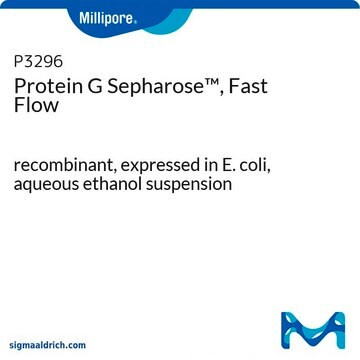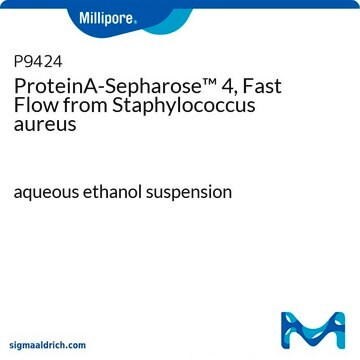推薦產品
ligand
recombinant protein G lacking albumin-binding region
包裝
pack of 5 mL
製造商/商標名
Cytiva 17-0618-01
儲存條件
(20% Ehtanol)
基質
4% cross-linked agarose
平均直徑
90 μm (d50v)
cleaning in place
2-10
工作範圍
3-9
適合性
suitable for bioprocess medium
儲存溫度
2-8°C
相關類別
一般說明
Protein G Sepharose™ 4 Fast Flow has recombinant protein G immobilized by the cyanogen bromide (CNBr) method to Sepharose™ 4 Fast Flow. Protein G exhibit binding specificities that complement Protein A media and binds to the Fc region of IgG from a variety of mammalian species. Protein G Sepharose™ 4 Fast Flow may be used to isolate and purify classes, subclasses and fragments of immunoglobulins from any biological fluid or cell culture medium.
As member of the BioProcess media range, Protein G Sepharose™ 4 Fast Flow meets industrial demands with security of supply and comprehensive technical and regulatory support.
特點和優勢
- Binding specificities that complement Protein A media.
- Binds a broad range of IgG species and subclasses.
- Multi-point attachment minimizes ligand leakage.
- Used in a range of research applications.
儲存和穩定性
分析報告
法律資訊
相關產品
訊號詞
Warning
危險聲明
儲存類別代碼
3 - Flammable liquids
客戶也查看了
文章
This page shows a comparison of the relative binding strengths of protein G and protein A to different immunoglobulins.
本頁顯示蛋白 G 和蛋白 A 與不同免疫球蛋白的相對結合強度比較。
Purify monoclonal or polyclonal IgG from serum, cell culture supernatant or ascitic fluid using the HiTrap Protein G HP from Cytiva, an affinity-exclusion chromatography product containing Sepharose-immobilized Protein G.
條款
This page provides information about different pull-down assays for the further isolation of multiprotein complexes to identify their components with products from Cytiva.
本頁提供不同的下拉分析法資訊,以進一步分離多蛋白複合物,鑑定其成分與 Cytiva 的產品。
This page shows how to separate IgG antibodies by affinity chromatography using Protein G Sepharose 4 Fast Flow from Cytiva.
相關內容
利用親和、GST pull-down、TAP 和共免疫沉淀等方法,使用下拉試驗研究體外蛋白質與蛋白質之間的相互作用。
Investigate in vitro protein-protein interactions with pull-down assays, utilizing affinity, GST pull-down, TAP, and co-immunoprecipitation methods.
利用親和、GST pull-down、TAP 和共免疫沉淀等方法,使用下拉試驗研究體外蛋白質與蛋白質之間的相互作用。
This page shows how to separate IgG antibodies by affinity chromatography using Protein G Sepharose 4 Fast Flow from GE Healthcare.
我們的科學家團隊在所有研究領域都有豐富的經驗,包括生命科學、材料科學、化學合成、色譜、分析等.
聯絡技術服務









